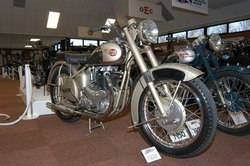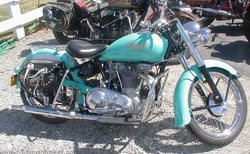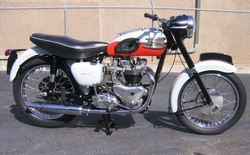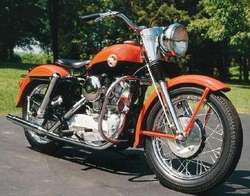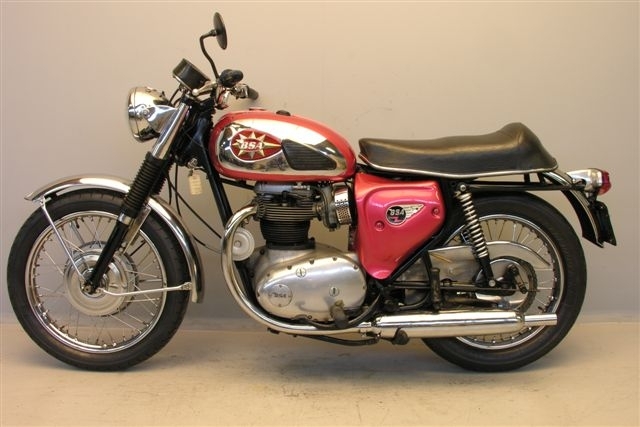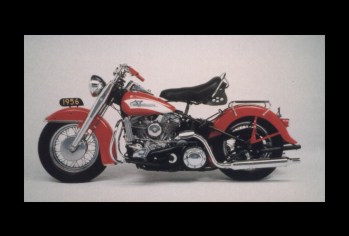1945-1962: WE SEE THE RISE OF THE BRITISH MOTORCYCLE EMPIRE TO THE PLATEAU OF THE AMERICAN INDUSTRY:
From WWII to the early 1960's, the motorcycle is refined. The British Builders Lead the Way as American Manufacturers Follow:
The crushing expense of the second world war causes the motorcycle builders to get off to a slow start but by the 1950's the momentum begins to climb. This is especially true of the British builders. By the mid 1950's. Triumph, BSA, Norton, Matchless (AJS), Vincent, and a host of other British manufacturers turn the fire up and lead the world in innovation. In America, Indian dies slowly while Harley becomes the single dominant manufacturer of motorcycles.
Below is the 1950 BSA A7 Golden Flash:
BSA, like most of the British manufacturers copied the Triumph Speed Twin. The A7 was a 500cc twin built as a sturdy and reliable machine. BSA was to become the worlds largest producer of motorcycles in the 1950's, but quickly lost ground in the 1960's.
Indian attempts to revive its line of motorcycles:
Indian was in trouble and tried to make some big changes quickly. The Scout series was a copy of the new British bikes but lacked the development. When they proved unreliable, Indian lost much ground in a battle they were already loosing. Few of these bikes remain and are very collectable today! A single cylinder was available in a 213cc version later updated to 249cc's then a twin of 426cc's was later changed to a 500cc version.
The classic 1959 Triumph Bonneville:
Introduced in 1959, the Bonneville was to become one of the great bikes of the 20th. century. It was an enlarged Speed Twin (from 500 to 650cc) with two Amal carburators. They produced 46hp when first sold and were considered a step away from racing bikes. At one time, they were the bike to have! Triumph did good, but failed to develop a more modern bike for the next decade.
Harley Davidson's Iconic Sportster:
Most of Harley's bikes were large road bikes. In the 1950's they offered the K series "sporty" roadster with a flathead 750cc engine. It couldn't compete with the new British bikes so in 1957, they introduced the K bike with an 883cc OHV engine and called it the Sportster. The one shown below is the XL version, later came the XLCH version, Harley's super bike of the day. The XLCH was called an "engine with two wheels" and was the bike to beat in the day!
BSA's answer to the Bonneville:
The BSA Lightening, a 650cc twin carb sporty bike was another great British bike. The BSA's never sold like the Triumph's, but were certainly beautiful bikes. The Triumph and BSA lines accounted for the vast majority of imported machines. It was only after BSA went off the market (1972-3) that many Nortons were seen. They represent some of the best of the early 1960's motorcycles.
Below is a 1962 Harley Davidson Duo Glide. This was the classic American motorcycle. Big, heavy, requiring great effort to handle, but great on the open road. The big Harleys both looked back to the 1930's but also forward to the huge cruiser market of today.
The Harley 74 (cubic inches) or 1200cc's was the largest motorcycle of it's time producing around 50 horse power. They were offered with either a 4 speed transmission or 3 speed with a reverse gear.
Key traits of this time period:
1. British motorcycles imports grow significantly in numbers throughout this period;
2. Harley becomes and remains the only dominat American motorcycle manufacturer;
3. The British V-Twin dissapears and the twin dominates, in the US, the V-twin remains the dominant configuration;
4. The motorcycle becomes the choice of the "rebels" (along with the hot rod) after WWII; the motorcycle gang emerges as a group to be feared, where they existed (almost always in larger cities);
5. Over 300,000 US motorcycles were built for the war effort, this huge number helps in the development of the American motorcycle in general;
6. After the war, all bikes (with the exception of very few) had telescopic forks, rear swingarm suspension, 4 speed transmissions, OHV engines, and significantly better brakes than what existed before the war;
7. In America the motorcycle had become a machine for either the gearhead, the rebel, or the racer. In Europe, the motorcycle filled those categories but was also a major source of general transportation as well.
8. Sochiro Honda builds his first motorcycle facility in 1947 and he comes to America in 1959. Within a decade Honda transforms motorcycling.
